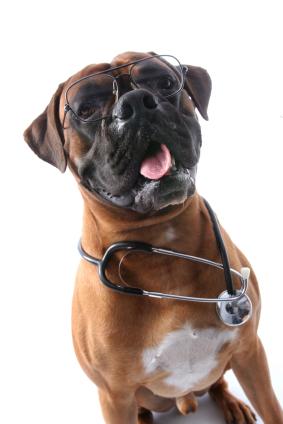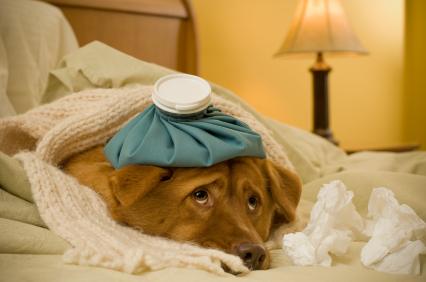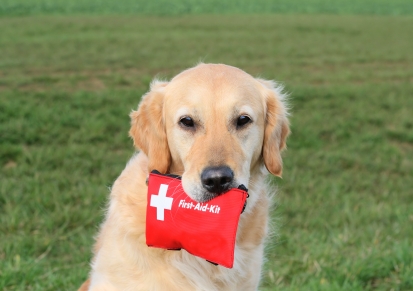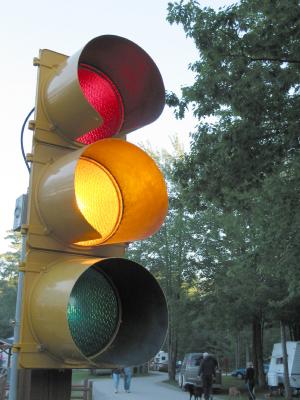|
Your Dog's Health
Your dog's health is paramount to his happiness and longevity. Regular visits to your veterinarian are an absolute must (don't let anyone tell you otherwise!), but vigilance at all times--and some basic helpful techniques--can help to alleviate some issues, or even prevent them from happening. Choosing a Veterinarian Choosing the right veterinarian should be the first priority in your furry child's health and happiness. If you're lucky enough to have several veterinarians in your community, you'll want to 'interview' each one of them before you make a choice. You may not be comfortable with a particular veterinarian's personality or 'bedside manner'. Also, some veterinarians practice traditional Western medicine only and may not be open to alternative treatments. If you're more of a 'holistic' mind, as we are, you may want a veterinarian that practices both Western and alternative medicine, so you'll get the best of both worlds. (Getting as much information as possible from all sides is in your CBF's best interest--and yours.) Alternative treatments can include such techniques as acupuncture, massage, and herbal supplements.
Click here to learn more about alternative veterinary treatments.
Common Diseases Dogs can suffer from many of the same diseases as humans, including some of the more serious ailments, such as cancer. Familiarizing yourself with the various symptoms of the more common diseases can help preserve your CBF's health--and get him the speediest and best treatment when he needs it most. Some of the most common diseases are:
1. Stomach ailments--many times, these are caused by your canine pal eating the wrong thing--or just plain eating too much. (Remember that old commercial where the man keeps groaning "I can't believe I ate the whole thing"?) You must first determine that he didn't ingest something that is truly harmful. If it's just a case of eating too much, a simple remedy such as Pepto-Bismol can make him feel a lot better. (But beware--many dogs do NOT like the taste!) If he has diarrhea, you can try Kaopectate. Dosage is 1/2 to 1 teaspoon per 5 pounds of body weight, with a maximum of 2 tablespoons every 8 hours. You might also try a couple of tablespoons of plain yogurt. Most dogs love this--just make sure the brand you use has probiotics in it. These 'friendly' bacteria will help normalize his digestive tract. Plus--they're just a good idea to add regularly to boost his health. You should always check with your veterinarian before administering any over-the-counter medication. 2. Allergies--dogs, like humans, can become allergic to foods or plants. Common allergens are grains (wheat, corn, soy) and outdoor grasses. Some dogs also are allergic to chicken (not mine!). Unlike humans, whose allergies usually manifest in upper-respiratory symptoms, allergies in pets more often show up as itchiness and 'hot spots' (which are areas that he has licked or chewed to the point of irritation). We discovered Buster's wheat allergy almost by accident!! We knew he was allergic to SOMETHING, but our veterinarian was having trouble pinpointing the troublemaker. Then, one night, we gave Buster a couple of Triscuit crackers. At about 2:00 a.m., we were awakened by him pacing, panting, scratching, and digging at his ears. We gave him some ear drops we had on hand and that calmed him down, so we all went back to sleep. A couple nights later, we gave Buster a couple bites of rye bread. You guessed it...at about 2 a.m the same thing happened. The culprit in both food items? Wheat!! Needless to say, Buster no longer gets ANYTHING containing wheat in any form--in fact, we keep the grains in his diet to a bare minimum. Consult with your veterinarian if you suspect he may have allergies.
3. Skin conditions--these can be caused by allergies (as outlined above), or can also be caused by genetic tendencies. They can also be caused by incorrect or too-frequent bathing. Some dogs, like humans, can develop dandruff. A more serious skin disease that pets can get is mange. There are two types of mange, sarcoptic and demodectic. Both types are caused by a mite. The mite that causes demodectic mange is naturally present on dogs and usually causes no harm; however, if an animal's immunity is suppressed due to malnutrition or lack of care, the mite can reproduce rapidly, causing symptoms ranging from mild irritation to a potentially life-threatening situation. The treatment for milder cases usually involves medicated shampoos and topical treatments aimed at killing the mites. More serious cases can involve a secondary infection which may be treated with antibiotics. The mite that causes sarcoptic mange rapidly burrows deep into the skin and causes intense itching and crusting which becomes infected and results in fur loss. Skin damage often occurs, along with secondary infections. Advanced sarcoptic mange is very painful and may result in death. The most common treatment for sarcoptic mange is an anti-parasitic rinse. Both types of mange are usually diagnosed by skin scrapings viewed under a microscope. Consult with your veterinarian if you think he has a skin condition. He or she can recommend the best course of treatment--and will let you know if the condition is symptomatic of a more serious threat to his health. 4. Fleas and ticks--if your pup spends any time at all outdoors, especially in summer or warmer climates, or if you and he are 'regulars' at the local dog park, it's almost inevitable that he'll get fleas. These nasty little blood-sucking critters reproduce rapidly and can get into your carpets and furniture, so it's essential to nip the problem in the bud. Ticks are not actually insects; rather, they are members of the arachnid (eight-legged) family, like spiders. These little evil-doers like to hide in long grasses and weeds. They will attach themselves to your dog and burrow under the skin, where they will feed off blood and spread diseases such as Lyme disease, which gets its name from Lyme, Connecticut, where one of the first cases was documented. This disease causes swollen, tender joints and a high fever which must be treated with antibiotics. Ticks can be removed by grasping near the tick's head with tweezers and carefully pulling it straight out. Make sure you don't break the tick's head off and leave it in his skin. If the head stays on, there's a higher risk of infection and will require a trip to the vet's. Fortunately, there are several remedies available that are very effective in eliminating fleas and ticks. Click here for some useful and safe solutions. 5. Ear infections--most common in canines with long, floppy, or furry ears, such as Cocker Spaniels, Beagles, Basset Hounds, Golden Retrievers, and Labrador Retrievers. Since a dog's ear canals are not designed to drain efficiently, moisture can easily be trapped in the ear, providing the perfect environment for bacteria to flourish. If he is scratching or digging at his ears, or shaking his head, look at his ears. If they look red or irritated, or have any kind of discharge, or smell musty or 'yeasty', chances are he has an ear infection. Have your veterinarian examine your pet's ears to make the proper diagnosis and prescribe the most effective treatment. If he has a yeast infection in his ears, you may help him get 'back in balance' by adding a couple of tablespoonsful of plain, unflavored yogurt (read the label and make sure it has probiotic cultures and NO SUGAR!! Yeast organisms LOVE sugar!!) to his meals. Most dogs love yogurt. You might also try adding a teaspoonful of white vinegar to a cup of warm water and using a cotton ball soaked in this solution to wipe out the inside of his ear flaps. Make sure you don't get the solution too far into his ear. Vinegar is antifungal and anti-yeast. Whenever you and your CBF are enjoying some quiet 'cuddle' time together, familiarize yourself with the way his bones, skin, and coat look and feel. Also look at his mouth and teeth. That way, you'll notice right away if anything feels 'abnormal', such as a lump or bump that wasn't there the last time you petted your dog. If you find any kind of abnormality while petting him, contact your veterinarian. He will likely want to examine him and run any appropriate tests to see if the abnormality requires further action.
Click here to learn about some of the more serious illnesses.
Your First Aid Kit A first aid kit is essential for when your furry buddy gets a minor cut or scrape, an insect bite, or a bee sting. Here are some basic items to have on hand: 1. Rectal thermometer (and lubricant, such as Vaseline or K-Y Jelly) 2. Different sizes of sterile non-stick pads 3. Antibiotic ointment 4. Adhesive tape 5. Styptic pencil 6. Ice pack (the reusable gel packs are great) 7. Roll gauze 8. Elizabethan collar (also known as a 'lampshade'!) 9. Hydrogen peroxide (3%) as a topical antiseptic These items are all easily obtained at your local drugstore, except for the Elizabethan collar. You'll find this at a pet-supply store or your veterinarian's. Always consult with your veterinarian when treating your dog for any injury. He may require more extensive treatment than what you are able to provide at home. Click here to learn some first-aid techniques.
Keeping Your Dog Safe You can't keep him in a bubble, but there ARE precautions you can take which will go a long way toward keeping him happy and healthy. Here are some basic steps to follow: 1. NEVER, EVER, EVER allow him to roam loose. Beside the fact that this is illegal in most communities, by doing so, you are setting him up for an emergency waiting to happen. It is also not a good idea to tie him up outside. He could easily wind himself around a tree or get tangled in a shrub and strangle, and he's also vulnerable to attacks by other animals or even humans. He could choke himself while straining to get to objects or animals. He can pick up parasites or suffer from hypothermia or heatstroke from being out in the elements too long. The best place for your dog (besides being indoors) is in a clean, totally fenced-in yard. Make sure the fence is high enough to contain him if you know he's a jumper. (Just a note here: I've seen a Jack Russell Terrier easily clear a four-foot chainlink fence.) You also need to make sure that the bottom of the fence is secure as well so he can't dig under it. Some neighborhoods do not allow actual physical fences. 'Invisible' fences consist of buried electrical wires that administer a low-voltage shock to him if he crosses over the wire. There are a few problems with this type of fence. First of all, he must be wearing the collar that comes with the fence. No collar, no shock...and no pet in your yard! Another issue is that some dogs will run right through the shock if they spot something particularly enticing on the 'other side'. You should make sure that he has shade and a shelter such as an insulated house, which should be large enough for him to stand up and turn around in. Lastly, you should never leave him outside when nobody is home, just as you would never leave your child outside alone in your yard when you're not there. Although you may think your yard is totally safe for him, any number of things could happen while you're gone. He could ingest a poisonous plant or chemical, or encounter a wild animal that has wandered into your yard--and you won't be there to deal with the situation. If you live on a corner, your dog is susceptible to provocation by passers-by. I know of two incidents in my neighborhood where the owners left their dogs outside all day while they were at work. Both owners lived on corners. Both pets had been sweet, friendly animals at first, but became confrontational and aggressive within a short timespan. Both ended up biting someone...and both were euthanized. You DON"T want this to happen to your dog!! 2. Your dog should have some form of identification on him at all times. All communities require dogs to be licensed, but it is also advisable to have him wear an ID tag with his name and your name, address, and telephone number. I have also heard of owners having the word 'REWARD' on the tag. This obviously is an inducement to return your dog to you if he is found wandering! Another form of identification is a microchip. The chip is about the size of a grain of rice and contains all your dog's vital information. Your veterinarian injects the chip just under his skin. Veterinarians and shelters can then use a scanner to 'read' the chip and identify your pet in the event he is lost or stolen. 3. Keep all houseplants, medications, household cleaners, lawn/garden chemicals, antifreeze, insecticides, and foods out of his. Many of these items contain compounds that are toxic to dogs. For instance, chocolate contains a stimulant called theobromine which is poisonous. Antifreeze has a sweet taste which is appealing to animals. The culprit here is ethylene glycol, which is metabolized by the liver to form a toxin that shuts down his kidneys. As little as a half-cup of antifreeze can kill a 20-lb. dog. There is an antidote, but it must be administered within an hour or so after he has ingested the antifreeze--so if you think your dog has ingested this toxin, call your vet IMMEDIATELY. Do not administer any antidote unless you vet directs you to do so. For household cleaners and lawn/garden chemicals, try to use an organic or natural alternative. There are many products available that are plant-based and are not only safer for your pet, but for the environment as well. It is also suspected that some of the chemicals commonly used by lawn services can cause lymphoma (a cancer) in dogs. As far as houseplants go, here is a list of common houseplants that are poisonous: Azalea, belladonna, datura, henbane, jessamine, jimsonweed, caladium, dieffenbachia, philodendron, crown of thorns, English ivy, daffodils, tulips, wisteria bulbs, foxglove, larkspur, lily of the valey, monkshood, oleander, holly, Jerusalem cherry, potato (green parts and eyes), nightshade, lily, mother-in-law's tongue, rhubarb, seeds and pits of apples, apricots, cherries, peaches, and hydrangeas (all contain cyanide), walnut hulls, and yew. Here is a list of common household poisons: Acids (such as bleach and drain cleaners), alkalis (such as ammonia and laundry detergents), antifreeze, baker's chocolate (any chocolate is bad, but the darker the chocolate, the more toxic to dogs), coal-tar products (disinfectants, treated wood, fungicides, tar paper), flea products (Frontline, Advantage, etc.), lead (from paint, linoleum, golf balls), pain medicines (although dogs can take aspirin--preferably buffered--in small doses--acetaminophin and ibuprofen are toxic), pest baits, petroleum products (such as motor oil, gasoline, paint, kerosene, turpentine). If you suspect your pet has ingested ANY of these listed above, call your veterinarian IMMEDIATELY!! He (or she) may instruct you to administer an antidote, but PLEASE don't do this without being instructed to do so. You may also call the National Animal Poison Control Center, which is administered by the ASPCA, at 800-446-4435. There is a charge for this service. 4. Keep your dog away from machinery. Many dogs do not like the sound of lawn equipment or vacuum cleaners anyway, but you still need to be mindful of where he is at when you operate such machinery. He should be indoors when you are working on the lawn. Other machines that can hurt him aren't so obvious. I have heard of a dog whose tongue was severely cut in a paper shredder that was on 'automatic'--this makes me absolutely cringe! 5. Don't leave your dog in the car. This should be a no-brainer, but I am continually amazed by the number of owners who do not heed this advice. Your pet is wearing a fur coat and his body is not very efficient at cooling itself. A closed car gets very hot very quickly--to see for yourself, try sitting in a car on a warm summer day with the windows open perhaps an inch, wearing a heavy coat. You'll get uncomfortable very rapidly. A couple of years ago, I was out walking Buster on a very warm sunny morning and passed a driveway containing a dark-blue car with the windows COMPLETELY CLOSED. Inside was a Schnauzer, frantically barking. I immediately called 911, and a police car was dispatched to the home. This is an extremely dangerous situation and can kill your dog in a very short time. PLEASE don't do it!! Another 'no-no'--if you have a pickup truck with an open bed, don't let your dog ride loose back there. Besides being illegal in some places, he is at a huge risk. He could jump out (or be thrown out) into oncoming traffic. If he is tethered in, he could be hanged. If you absolutely must transport your dog in this type of vehicle, place him in a pet carrier which is securely strapped into the truck bed. Ideally, the best place for him to ride is in the center of the back seat, secured in a seatbelt harness. Another danger is letting your dog hang his head out the window. I am appalled at the number of dogs I see hanging out of open car windows. Your dog may love the feel of the wind in his face, but I can guarantee he WON'T like the feel of debris in his eyes! And if you have to swerve or hit the brakes suddenly, he could fly out the window. Worse yet, he could be decapitated by a vehicle passing too close to yours. Also--if he's a small guy, PLEASE don't let him ride in your lap when you drive! Not only does it distract you (and possibly obstruct your vision), think about what will happen to your dog if your airbag deploys. Need we say more? If you follow these precautions, your dog--and you too--will be much safer and happier!
|









